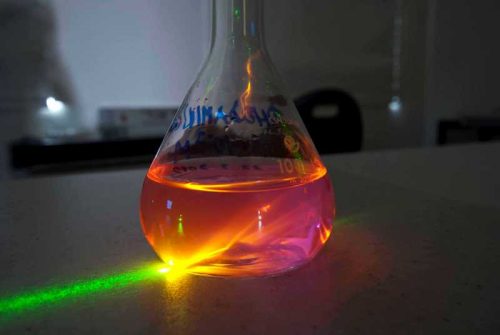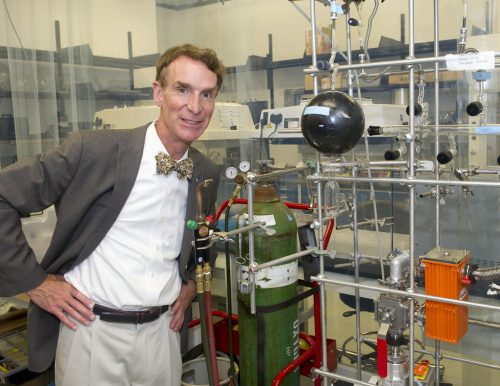Whether you’re conducting experiments in a lab because it’s a required course for your degree or because you hope to become the next Marie Curie, one fact remains the same: you need to write a lab report after conducting your ground-breaking experiment.
The idea of a science lab report might be new to you, but I bet you’ve written at least a few reports in your day.
Ever written a book report or a report about a historical figure? Sure you have. While book reports and history reports aren’t quite the same as lab reports, they do have one thing in common: the word “report.”
That’s right, they’re all reports. This means—get ready for the obvious—you need to report information. Sounds logical enough, right?
A scientific lab report simply means you need to report the following:
- The purpose and hypothesis of your experiment
- How you conducted your experiment
- The results of your experiment
- The implications of your experiment
Presto! Report complete!
In case you need just a little more explanation, here’s how to write a science lab report that gets results.
How to Write a Science Lab Report That Gets Results

Like most other writing assignments, lab reports generally follow a pattern. A lab report usually includes the following sections:
- Introduction
- Methods
- Results
- Discussion
You may be required to include additional sections, such as an abstract, so make sure to check with your instructor before you begin. (Read How to Write an Abstract for a Research Paper.)
If you’ve referenced any sources in your report, you’ll also need to cite your information (most likely in APA format).
If you’re not quite ready to write the report and need more advice about how to prepare, read 5 Easy Tips for a Better Lab Report Format.
Let’s start our science lab report in the beginning, with the introduction.
Introduction
The introduction of a scientific report should include your overall purpose for completing your research, as well as your hypothesis.
Your introduction will be only a few paragraphs long (and will definitely be no longer than one page).
Purpose: The purpose should explain, in broad terms, what you hope to gain from the experiment.
If you’re conducting an experiment with a frozen pizza and a pizzeria pizza, your purpose might be to see how long you can keep the cooked pizzas in the fridge before mold starts to grow.
Hypothesis: The hypothesis should explain what you expect to learn from the experiment and what you think will happen in your experiment.
You might hypothesize that mold will grow on the pizzeria pizza before it will grow on the frozen pizza because a frozen pizza contains more preservatives.
Remember, the purpose and hypothesis are different from each other. The purpose explains what you hope to accomplish. The hypothesis is what you expect to happen.
Methods
The methods section explains what you did in your experiment. The goal is to provide enough detail so that readers understand exactly how you conducted your experiment. This also gives them the information they need to replicate the experiment.
This section will contain a fair amount of detail, so it will likely be at least a page or two long.
The Pizza Experiment
Your pizza experiment methods sections would explain details such as which pizzeria pizza and which frozen pizza you used in the experiment. It might also explain how often you checked the pizza for changes, how long you left the pizza slices in the refrigerator, and at what temperature the fridge was set. You’ll also include a description of how you recorded the information.
Details are key in this section, so what I’ve included above is just a quick synopsis of the type of content you might include. Your write-up will contain much more specific detail. Remember, you’ll need to have enough information so that someone else could complete the same experiment.
A note about style: In most essays, you’re told to write in active rather than passive voice, but here’s a case where the opposite is true.
When writing scientific lab reports, you’re often asked to write in third-person point of view and in passive voice. This is because the focus is on the experiment and not the researchers.
There are instances, however, where your prof would prefer that you write in first-person active voice. (Check with your prof to see which is preferred.)
Here’s a quick example to illustrate the differences:
- First-person active: I put the pizza slices in the refrigerator.
- Third-person passive: The pizza slices were placed in the refrigerator.
Also, don’t forget that the experiment took place in the past, so write in past tense.
Results

The results section is just like it sounds. It reports the factual results of your study. It explains what happened when you completed your experiment.
This section is the shortest part of your report and should be no longer than a paragraph or two.
You might decide to include charts, tables, or graphs in this section, but do so cautiously. If you can clearly and succinctly discuss the facts and figures in a few sentences, there’s no need to include the same information in a table.
Think of using tables like using quotations in an essay: only use them when you can’t say it better using a few lines of your own writing.
The results section, like the methods section, should be written in past tense.
The Pizza Experiment
The results section of your pizza experiment would explain if you found mold on either slice of pizza, how long it took for the mold to appear, and how much mold appeared.
In some cases, your hypothesis might be wrong. In the pizza experiment, you hypothesized that mold would grow on pizza, but if it didn’t grow, you’ll need to document that in your lab report.
Discussion
The discussion section is where you’ll have a chance to explain the “so what” of your experiment. In this section, you’ll explain the following:
- Whether your experiment met your hypothesis
- What this means for other experimentation that you (or other scientists) might conduct
- How your experiment fits into the larger scientific community
- Any concerns or problems you had with your study
You’ll also give a review of the literature.
The concerns or problems section of your discussion might address your own mistakes or perhaps what you’d do differently if you repeated the experiment. For instance, maybe you felt that you should place the pizza in different containers, or maybe you thought you should use several other types of pizza.
Either of these variables might change the outcome of your experiment. (Your failures aren’t the focus of your work, though, so don’t dwell on these in your report.)
In your literature review, take a look at other studies in scholarly, scientific journals to see what types of research has already been conducted. As you discuss the results of their findings, you will explain how your experiment fits into the larger discussion.
Perhaps there’s only limited research in this area of study, so you’ve just conducted ground-breaking pizza experimentation!
As you can see, the discussion section will be the longest section of your report and will be about 3-4 pages. (Of course, your professor might ask that you include more detail or your experiment may be quite complex, so this section could be even longer.)
The Pizza Experiment
In the pizza experiment, you would discuss whether mold grew on the pizza and what this means. Does this mean that one pizza had more preservatives or that it was more resistant to mold for some reason? If mold appeared after two weeks, does this mean it’s safe for people (such as college students) to eat almost two-week-old pizza? Can you speculate as to which of the pizzas is healthier? Has anyone else completed a pizza experiment? Your discussion would likely include an overview of similar experiments and a discussion of how your experiment compares.
When writing the discussion section, you’re writing about your findings and their implications to the present. Thus, this section of your science lab report should be written in present tense.
A note about style: Be careful with word choices. It can be easy to say things like, “This experiment proves that pizza can be left in the refrigerator for eight days.” While these might be the results of your study, one basic study cannot prove such things. Instead, use words like “indicates” or “suggests.”
Officially a Scientist

With your lab report complete, you can officially call yourself a scientist. You know, like the guy pictured above—complete with bow tie.
By the way, the guy pictured above really is an official scientist—Bill Nye (the Science Guy). You may have watched his kid’s show at one point in your life or might have followed some of his other work. You can even try one of his basic demos if you need some experiment ideas of your own.
Check out these additional science lab reports for inspiration:
If results indicate you’re an awesome scientist, but you’re not sure of your writing skills and you’d rather not experiment with your grade, let a Kibin editor help you get the results you want.

